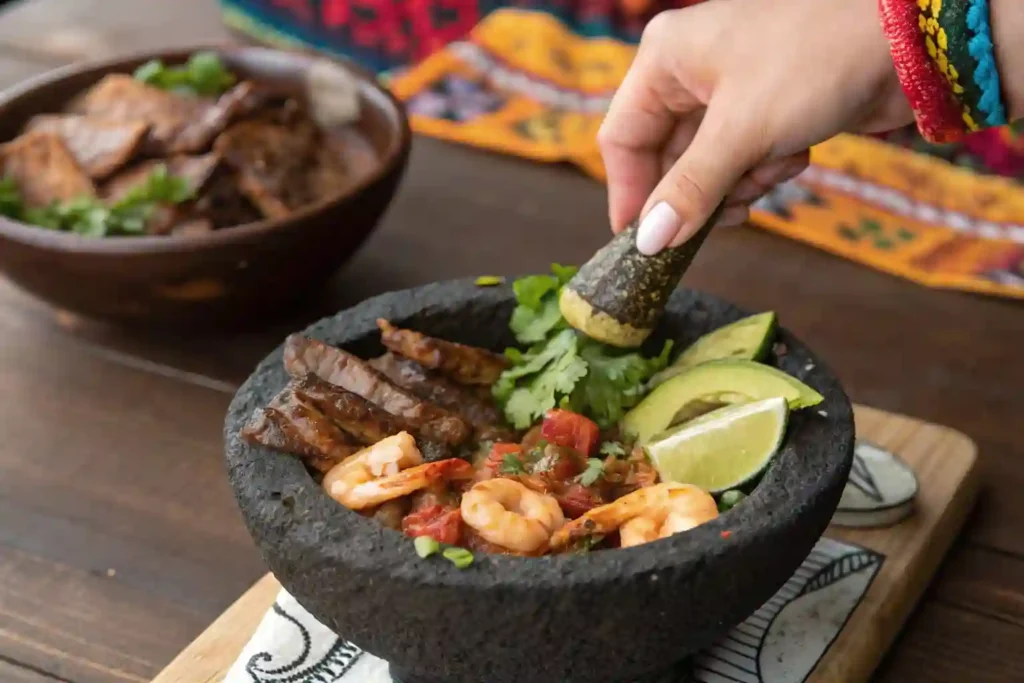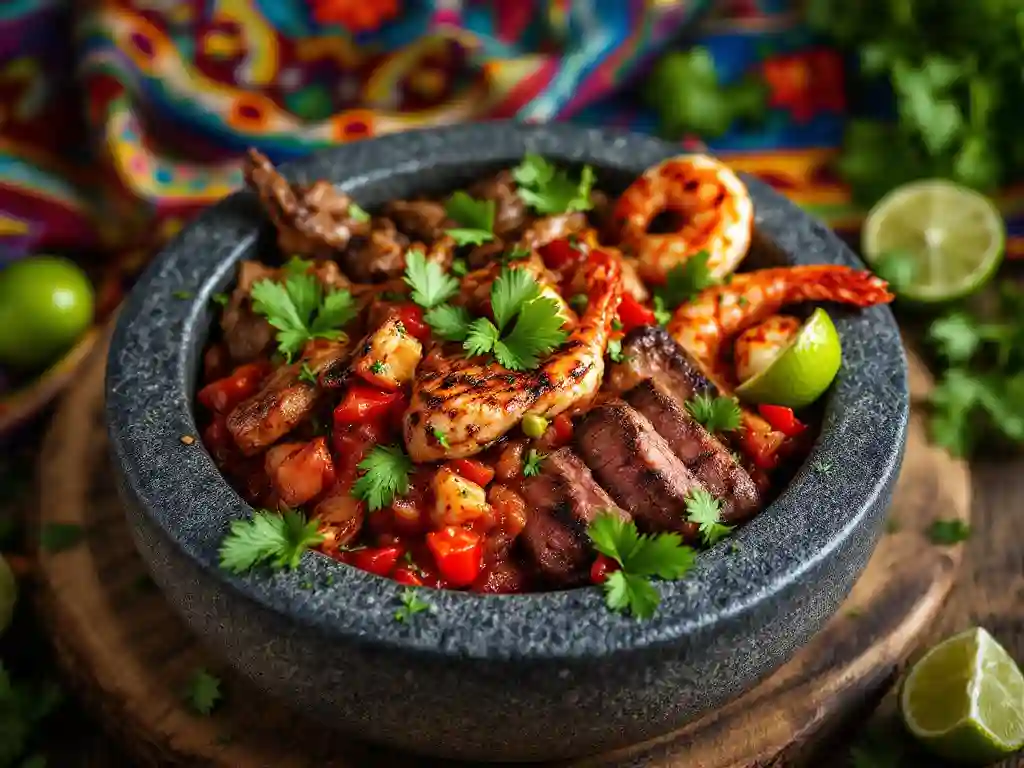Mexican cuisine is a treasure trove of flavors, aromas, and cultural traditions, with the molcajete at its heart. This traditional volcanic stone mortar and pestle serves as both a tool and a serving vessel, renowned for its ability to create robust, authentic flavors. A molcajete is more than just a utensil—it’s a symbol of heritage and community.
Table of Contents
1. What is a Molcajete?
The molcajete is a traditional Mexican kitchen tool made from volcanic basalt stone. Its rough surface makes it ideal for grinding and blending ingredients, allowing flavors to meld in a way that modern blenders or food processors can’t replicate. The molcajete’s history dates back thousands of years to pre-Hispanic times, where it was used by the Aztecs and Mayans to prepare food and medicinal concoctions.
Traditional Uses of the Molcajete
The molcajete is most commonly used for grinding spices, preparing salsas, and mashing guacamole. Its accompanying pestle, known as a tejolote, is perfectly shaped to fit into the basin, making the grinding process efficient and intuitive. In many Mexican households, the molcajete recipe also doubles as a serving dish, offering a rustic and authentic presentation that keeps food warm for longer due to its heat-retaining properties.
Significance in Mexican Culture
The molcajete is more than just a cooking tool; it represents Mexican culinary traditions passed down through generations. The act of preparing food in a molcajete often involves family members gathering in the kitchen, sharing stories, and bonding over the cooking process. It embodies a sense of community, heritage, and pride in preserving ancient methods of cooking.
2. Choosing the Right Ingredients
An authentic molcajete dish relies on the quality and freshness of its ingredients. Therefore, here’s what you’ll need and how to select the best:
Key Ingredients for a Traditional Molcajete
- Vegetables and Aromatics
- Tomatoes: Ripe Roma tomatoes are ideal for a rich, flavorful base.
- Chilies: Use serrano or jalapeño chilies for spice, or ancho chilies for a smoky touch.
- Onion and Garlic: Essential for a deep, savory profile.
- Cilantro: Adds a fresh, herbal kick.
- Proteins
- Beef and Chicken: Skirt steak and chicken thighs are popular choices for their tenderness and flavor.
- Seafood: Shrimp or fish can be used for a coastal twist.
- Vegetarian Options: Opt for hearty vegetables like mushrooms, zucchini, or cactus paddles (nopales).
- Spices and Seasonings
- Cumin and Oregano: Enhance the dish’s earthy flavors.
- Salt and Pepper: Balance the overall taste.
- Lime Juice: For a tangy contrast.
Tips for Selecting High-Quality Ingredients
- Tomatoes and Chilies: Look for firm, vibrant-colored produce with no blemishes.
- Meats: Choose cuts with good marbling and freshness.
- Spices: Use freshly ground spices for maximum aroma and flavor.
- Herbs: Opt for bright green, aromatic cilantro leaves.
The Role of Fresh Ingredients in Flavor
Freshness is crucial when making a molcajete recipe. In particular, the robust flavors of roasted vegetables, the tenderness of grilled meats, and the zing of freshly squeezed lime juice all come together to create a harmonious balance. Conversely, using stale or low-quality ingredients can dull the vibrant profile of this beloved dish.
3. Preparing the Molcajete

Before diving into the recipe, it’s essential to prepare your molcajete properly. This step is crucial because it ensures its longevity and optimal performance, as well as preventing grit from affecting the texture of your dish.
Seasoning a Molcajete Before Use
If your molcajete is new, it must be seasoned to remove any stone dust and smooth out the surface. Here’s how:
- Rinse Thoroughly: Wash the molcajete and tejolote under running water. Avoid soap, as it can seep into the porous stone and alter flavors.
- Grind Uncooked Rice: Place a handful of uncooked rice in the molcajete and grind it using the tejolote. Continue grinding until the rice turns grayish, which indicates it has absorbed the residual stone particles. Discard the rice.
- Repeat: Repeat the process with fresh rice until the ground rice remains white.
- Season with Garlic and Salt: Add a few cloves of garlic and a pinch of salt, then grind until the mixture becomes a paste. This step helps build a natural, flavorful seasoning layer.
Cleaning and Maintaining Your Molcajete
To keep your molcajete in good condition:
- Always rinse it immediately after use with warm water.
- Use a stiff brush to remove food particles.
- Let it air-dry completely before storing to prevent mold.
- Avoid using soap or detergents.
4. Step-by-Step Molcajete Recipe
Ingredients for the Molcajete Recipe
- For the Salsa
- 3 Roma tomatoes
- 2 serrano chilies (or adjust for spice preference)
- 1 small white onion, quartered
- 3 garlic cloves
- 1 teaspoon of salt
- 1 tablespoon lime juice
- ¼ cup chopped cilantro
- For the Meats and Toppings
- ½ lb skirt steak
- ½ lb chicken thighs
- ½ lb large shrimp, peeled and deveined
- 2 teaspoons cumin powder
- 2 teaspoons smoked paprika
- 1 teaspoon salt and pepper, each
- 2 tablespoons olive oil
- Optional: roasted cactus paddles (nopales), queso fresco, and avocado slices
Directions for Cooking:
First, roast the vegetables.
- Preheat a skillet or grill. Roast the tomatoes, chilies, onion, and garlic until their skins are charred and blistered. This process enhances their smoky flavor.
2. Grind in the Molcajete
- Next, place the roasted garlic and chilies in the molcajete recipe. Using the tejolote, grind them into a rough paste. Add the roasted onion and tomatoes, grinding them until combined. Adjust the texture to your preference—chunky or smooth. Add salt, lime juice, and cilantro, and mix thoroughly.
3. Prepare the Meats
- Marinate the skirt steak, chicken thighs, and shrimp with olive oil, cumin, smoked paprika, salt, and pepper. Let them sit for 20 minutes to absorb the flavors.
4. tGrill the Meats
- Heat a grill or skillet over medium-high heat. Cook the steak for 4–5 minutes per side, the chicken thighs for 6–8 minutes per side, and the shrimp for 2–3 minutes per side. Rest the meats for a few minutes before slicing.
5. Assemble the Molcajete Recipe
- First, heat the molcajete in the oven at 350°F (175°C) for 10 minutes to retain warmth. Then, pour the prepared salsa into the heated molcajete. Finally, arrange the grilled meats, shrimp, and optional toppings, such as roasted cactus, queso fresco, and avocado, around the edges.
5. Creating the Perfect Salsa
Indeed, the salsa is the heart of a molcajete recipe, providing a robust base that ties all the ingredients together. Achieving the perfect salsa requires attention to detail and a touch of culinary intuition.
Mastering Roasting Techniques
Roasting is essential for unlocking the natural sweetness and smokiness of the vegetables. Here’s how to get it right:
- Use High Heat: Whether you’re roasting over a grill, stovetop, or in the oven, ensure the heat is high enough to char the skins.
- Turn Frequently: Rotate the tomatoes, chilies, onion, and garlic to ensure even charring on all sides.
- Cool Before Peeling: Once roasted, let the vegetables cool slightly. For tomatoes and chilies, peel off the charred skin if you prefer a smoother texture.
3: Adjusting Spice Levels
The heat level of the salsa can be customized by:
- Removing Chili Seeds: For a milder flavor, deseed the chilies before roasting.
- Adding Mild Chilies: Combine serrano or jalapeño with mild chilies like poblano for a balanced heat.
- Taming Heat: A splash of lime juice or a pinch of sugar can mellow excessive spiciness.
Balancing Flavors
To achieve a well-rounded salsa:
- Ensure the right ratio of acidity (lime juice) to sweetness (tomatoes).
- Add salt gradually, tasting as you go to avoid over-seasoning.
- Cilantro should be added sparingly to prevent it from overpowering the salsa.
6. Grilled Meats for Molcajete Recipe

Furthermore, the grilled meats in a molcajete dish add depth and protein to the dish. Their smoky, charred flavors complement the fresh vibrancy of the salsa.
Choosing the Best Cuts of Meat
- Skirt Steak: Known for its rich marbling, skirt steak becomes tender and flavorful when grilled properly.
- Chicken Thighs: More flavorful than chicken breasts, thighs remain juicy even when exposed to high heat.
- Shrimp: A quick-cooking protein that adds a briny sweetness to the mix.
Marination Tips for Maximum Flavor
A good marinade enhances the meat’s natural flavors while adding complexity. Follow these guidelines:
- Basic Marinade Ingredients: Combine olive oil, lime juice, minced garlic, cumin, smoked paprika, salt, and pepper.
- Time It Right: Let the proteins marinate for at least 20 minutes but no longer than 2 hours to avoid overwhelming delicate flavors.
- Experiment with Herbs: Add chopped cilantro or oregano to bring out earthy undertones.
Perfect Grilling Techniques
- Preheat the Grill: Ensure the grill is hot before placing the meat to prevent sticking and achieve proper searing.
- Sear First: Cook the meat over direct heat initially to lock in juices.
- Finish Over Indirect Heat: For thicker cuts like chicken thighs, move them to indirect heat to cook through without burning.
- Rest the Meat: Allow grilled meats to rest for 5 minutes after cooking. This helps retain juices and makes slicing easier.
Achieving the Smoky Molcajete Flavor
The smokiness of the grilled meats pairs beautifully with the roasted salsa. To intensify this effect:
- Use wood chips or a charcoal grill for an authentic smoky aroma.
- Char the edges of the meat slightly for added depth of flavor.
7. Frequently Asked Questions
For instance, can I use a blender instead of a molcajete?
While a blender can replicate the texture of salsa, it lacks the unique flavor imparted by grinding in a molcajete. The stone tool enhances the depth and complexity of the dish.
How do I clean a molcajete without damaging it?
Avoid using soap. Rinse with warm water and scrub with a stiff brush. Allow it to air-dry completely before storing.
Can I make a vegan version of this dish?
Absolutely! Use roasted vegetables, grilled tofu, or nopales as substitutes for meat. Adjust the salsa recipe to suit your preferences.
How can I season a molcajete quickly?
If time is short, grind a mixture of salt and garlic in the molcajete to prepare it for immediate use. However, a full seasoning process is recommended for long-term use.
What can I use if I don’t have a molcajete?
If a molcajete isn’t available, use a mortar and pestle or a heavy bowl with a rolling pin as a makeshift tool.
Can the salsa be made ahead of time?
Yes, the salsa can be prepared up to 2 days in advance. Store it in an airtight container in the refrigerator and reheat gently before serving.
Conclusion
In conclusion, the molcajete recipe is a vibrant and flavorful dish that brings the essence of Mexican cuisine to your table. This dish is perfect for gatherings and can be served with warm tortillas or rice. For a delightful pairing, consider trying Seafood Boil Sauce or Healthy Enchiladas, which complement the rich flavors of the molcajete beautifully. Additionally, for a classic take on a molcajete dish, check out Food.com for a recipe that highlights the traditional preparation methods. Embrace the joy of cooking and enjoy the robust flavors of this dish that is sure to impress your family and friends. With its combination of meats and spices, the molcajete recipe is bound to become a favorite in your culinary repertoire!

